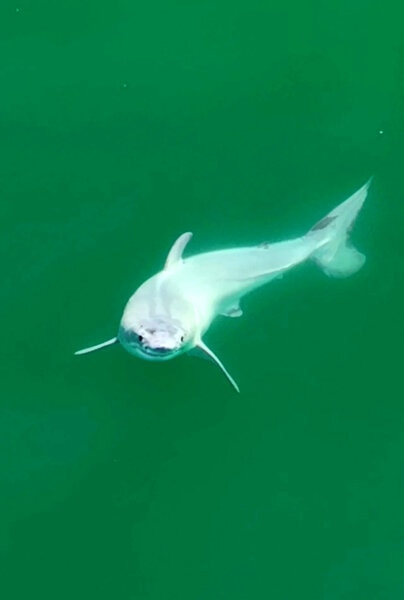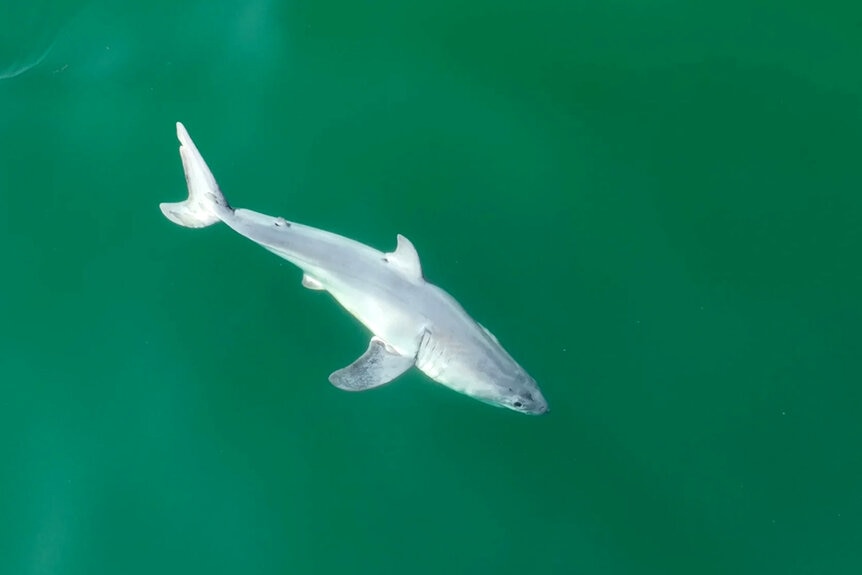Create a free profile to get unlimited access to exclusive videos, sweepstakes, and more!
Drone Footage Snaps Up the First Known Baby Photos of a Great White Shark (Probably)
Baby shark!
It’s often said that we fear what we don’t understand and there are few creatures more mysterious than great white sharks. It’s why Jaws remains such a cultural touchstone nearly 50 years after its release. Even their environment is mysterious, swimming the murky depths of the deep sea, and there’s so much we don’t know about the sharks themselves.
In addition to being the stars of countless monster flicks, white sharks are the rulers of the deep, the largest predatory fish in the world. Yet, we aren’t totally sure when, how, or where they are born. As far as we could tell from direct observation, they simply spring into existence as fully functioning juveniles. We’ve seen seemingly pregnant adults, we’ve found near-term embryos inside dead adults, and we’ve seen juveniles hunting off the coast, but no one had ever seen a newborn. Until now.
Drone Footage Captures Possible First Images of Newborn Great White
On July 9, 2023, wildlife filmmaker Carlos Gauna, who goes by the online handle The Malibu Artist, and University of California Riverside doctoral student Philip Sterns were gathering footage near Santa Barbara. They’d been flying a drone and filming sharks in the area for days when they came across something no one had ever seen before.
For More on Sharks:
Remember That Half-Eaten Great White Shark? DNA Evidence Identifies the Killer (Whale)
Great White Sharks Have a Mysterious Second Life in the Ocean's Twilight Zone
"Miraculous" Virgin Shark Birth Blesses Brookfield Zoo in Illinois
The drone’s cameras picked up images of what appeared to be a small white shark with unusually pale coloration. After playing the footage back in slow motion and examining the frames, Gauna and Sterns believe they captured evidence of a newborn great white, perhaps only hours or days old. The sighting was published in the journal Environmental Biology of Fishes.
Of course, images from a drone camera aren’t enough to make a definitive determination of what they saw, but Gauna and Sterns make a solid case while leaving the door open for other explanations. First, the images suggest that a whitish film was sloughing off the shark as it swam. They suggest that the shark’s pale coloring was a result of this film, with more typical coloring underneath.
As additional support for the newborn white shark hypothesis, they also note that large, likely mature sharks were seen in the area on the day the alleged newborn was seen, and on surrounding days. The footage was captured in an area which has been proposed as a possible white shark birthing area around the time they are believed to be born. Gauna and Sterns also note that the observed shark has characteristics consistent with the youngest confirmed white sharks and near-term embryos.
Lastly, they note that pregnant white sharks are known to secrete a milky substance in-utero which acts as a food source during gestation. Taken together, they propose that the tiny shark was a newborn, probably less than a day old. They suggest that the white substance covering it was intrauterine material still clinging to the body after just having been born.
“I filmed three very large sharks that appeared pregnant at this specific location in the days prior. On this day, one of them dove down, and not long afterwards, this fully white shark appears. It’s not a stretch to deduce where the baby came from,” Gauna said, in a statement.
The published paper is less conclusive and offers a possible alternative explanation. If the white material sloughing off wasn’t intrauterine material from being born, then it might be evidence of an unknown skin condition in sharks. The authors note, however, that there is nothing in the literature which explains the observed symptoms. We’re putting our preference down for baby shark, it’s cuter than mystery disease.
Rewatch Jaws, available from Universal Pictures, and try to imagine her as a slimy little baby.





























